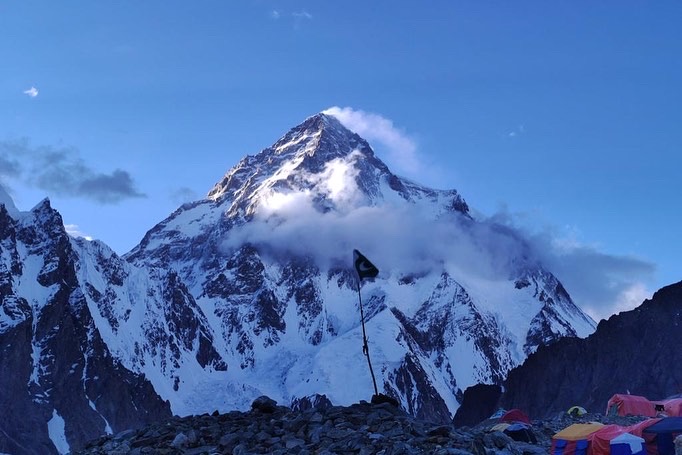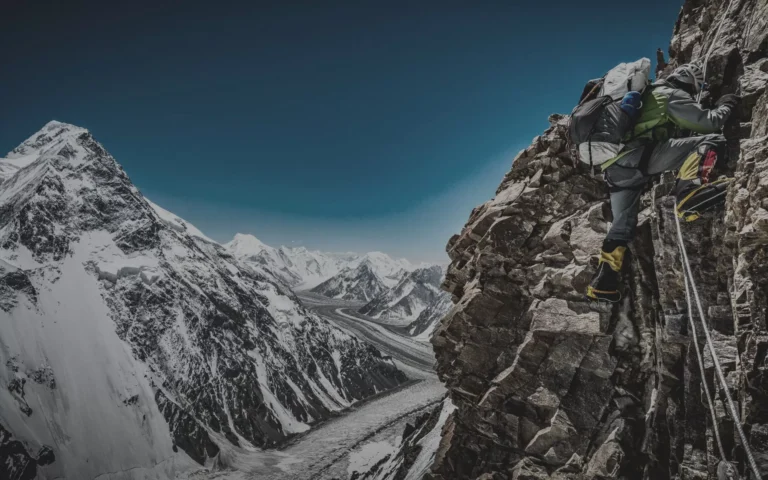Get to K2 Base Camp: A Complete Travel Guide
Get to K2 Base Camp: A Complete Travel Guide – If you’re dreaming of standing at the foot of the world’s second-highest mountain, this comprehensive guide will show you how. Reaching K2 Base Camp is an adventure that involves multiple stages: from arriving in Pakistan’s capital Islamabad, traveling to the mountain town of Skardu, and then trekking for days through rugged wilderness. In this guide, we provide a step-by-step roadmap covering transportation options (flights, road trips, and trekking routes), visa requirements, necessary permits, and essential local tips to make your journey safe and memorable.
Get to K2 Base Camp: A Complete Travel Guide – Overview of the Journey
Getting to K2 Base Camp requires careful planning and a series of distinct steps. Here’s an overview of how to get to K2 Base Camp: a complete travel guide in four major stages:
- Reach Islamabad, Pakistan: Begin your journey by flying into Islamabad, the capital of Pakistan (the usual international entry point).
- Travel from Islamabad to Skardu: From Islamabad, either take a domestic flight or embark on a road trip to Skardu – the gateway to the Karakoram mountains.
- Drive from Skardu to Askole: From Skardu, travel by Jeep on a rough mountain road to Askole, the last village accessible by road and the starting point of the trek.
- Trek from Askole to K2 Base Camp: Trek on foot through the Baltoro Glacier and Concordia for about a week to reach K2 Base Camp, then return via the same route.
Each of these stages is explained in detail below, so you can confidently navigate how to get to K2 Base Camp: A Complete Travel Guide from city to summit base.
Islamabad to Skardu: Starting Your Journey
Most travelers will start in Islamabad. From there, you have two primary options to get to Skardu, the launchpad for any K2 Base Camp expedition:

By Air (Islamabad to Skardu Flight)
Flying is the fastest and most convenient way to reach Skardu. A direct flight from Islamabad to Skardu takes about 45–60 minutes
. Pakistan International Airlines (PIA) operates daily or near-daily flights on this route (typically in the morning). The flight is scenic on clear days – you might even glimpse Nanga Parbat and other towering peaks. Note: These flights are weather-dependent and can be delayed or canceled if visibility is poor in the mountains
. It’s wise to plan an extra buffer day in your schedule in case your flight is canceled due to weather. Booking your flight well in advance (especially during summer trekking season) is recommended, as seats fill up fast with trekkers and climbers.

By Road (Islamabad to Skardu by Land)
Traveling overland from Islamabad to Skardu is an adventure in itself. The distance is around 600–640 km and typically takes about 16–18 hours of driving
. Most travelers break this journey into two days, with an overnight stop in a town like Chilas (if going via the Karakoram Highway) or Naran (if taking the Babusar Pass route in summer). The Karakoram Highway (KKH) route is open year-round and winds through dramatic gorges along the Indus River. The alternative route via the Kaghan Valley and Babusar Pass is shorter and more scenic, but only passable in the summer months (July–September). Public transport (such as NATCO buses or private vans) is available on the Islamabad–Skardu route, but many trekkers hire a private 4×4 or join a tour operator’s transport. The road journey offers stunning views of mountains and valleys, but be prepared for rough sections and long hours in a vehicle
. Ensure you have all necessary supplies, and start early to avoid traveling after dark on mountain roads.
Skardu to Askole: The Last Road Leg to the Trailhead
Skardu is the final town where you can stock up on any last-minute supplies, meet your guides/porters, and organize jeeps for the journey to Askole. Askole (also spelled Askoli) is a small village at about 3,050 m elevation, and it’s the last settlement accessible by road in the Braldo Valley. The drive from Skardu to Askole is approximately 126 km and takes about 6–7 hours by Jeep on a rough, unpaved road
. This ride is bumpy and can be nerve-wracking as it traverses narrow mountain tracks along steep gorges. Typically, only robust 4×4 vehicles with experienced drivers can handle this terrain.
Travelers usually arrange the jeep through their trekking agency or hire local drivers in Skardu. It’s common to depart early in the morning to reach Askole by afternoon. Along the route, you’ll pass through the Shigar Valley and enjoy views of the Braldu River. Essential tip: There are military checkpoints along the way, so keep your passport and permit documents handy. Sometimes the road conditions or landslides can cause delays – flexibility is key. As of now, Askole is the end of the road, and from here onward, you’ll be trekking on foot. (In recent years, road improvements have inched further up the valley, but Askole remains the main trailhead for K2 Base Camp treks.)
Trekking from Askole to K2 Base Camp
Once in Askole, the real adventure begins – the trek to K2 Base Camp itself. This is a demanding high-altitude trek covering roughly 90 km each way (about 180 km round-trip)

. Trekkers typically take about 8–12 days on the way up to ensure proper acclimatization, plus 4–5 days on the return (often a bit quicker descending). The route follows the Braldu River to the snout of the Baltoro Glacier and then ascends the glacier all the way to Concordia and K2 Base Camp. There are no villages or tea houses once you leave Askole – it’s true wilderness. You will be camping each night and relying on support staff (guides, porters, cooks) for logistics
.
Typical Trek Itinerary and Key Stops: While exact itineraries vary, most K2 Base Camp treks follow a similar route:
Askole (3,050 m) to Jhola Camp (~3,200 m): 6–7 hours trek along the Braldu River to the first camp
visitinpakistan.com
.
Jhola to Paiju (3,380 m): ~6–7 hours trekking. Paiju is often a rest spot, and groups spend an extra day here for acclimatization.
Paiju to Urdukas (4,130 m): 2 days of trekking on Baltoro Glacier via Khoburtse. Roughly 6–7 hours per day; stunning views start unfolding.
Urdukas to Goro II (4,300+ m): ~6 hours across the icy Baltoro expanse.
Goro II to Concordia (4,600 m): ~5–7 hours. Concordia is the famed junction of glaciers, offering a 360° panorama of granite peaks. Many expeditions camp at Concordia, known as the “Throne Room of the Mountain Gods,” to marvel at views of K2, Broad Peak, and the Gasherbrums.
Concordia to K2 Base Camp (~5,100 m): This final leg can be done in a long day: about 8–10 hours round-trip to K2 Base Camp and back to Concordia
visitinpakistan.com
. K2 Base Camp itself is a rugged area on the Godwin-Austen Glacier, marked by climbers’ tents during climbing season and prayer flags at the memorials. You’ll stand at the foot of K2’s mighty pyramid – a truly rewarding moment.
After reaching K2 Base Camp, most trekkers return to Concordia for the night and then retrace their steps back down the Baltoro to Askole (3–4 days back down). Note: Some itineraries exit via the Gondogoro La pass to Hushe, but that is a more technical route requiring mountaineering experience. For the scope of this complete travel guide, we assume you’ll return the way you came.
Throughout the trek, expect long days of walking (5–8 hours), stream crossings, and walking on rocky or icy terrain. Proper acclimatization is crucial – many itineraries include a rest day (often at Paiju and/or Concordia) to help your body adjust to the altitude. K2 Base Camp sits at over 5,000 m, so altitude sickness is a real concern; listen to your guide, and don’t rush the ascent. Adequate physical preparation, a good pair of broken-in trekking boots, and a spirit ready for adventure are must-haves.

Visa Requirements and Permits for K2 Base Camp Trek
Visa Requirements: Getting the right visa is a critical part of how to get to K2 Base Camp: A Complete Travel Guide for foreign travelers. Pakistan requires most foreigners to obtain a visa in advance. In particular, for trekking in restricted high-altitude border zones like K2, Pakistan issues a special Trekking and Mountaineering Visa (distinct from a standard tourist visa). As of recent regulations, you must apply for this trekking-specific visa well in advance (it can take 4–8 weeks for approval)
. The application will typically require an invitation or reference letter from a Pakistani tour company licensed for mountaineering treks
. It’s advised to start the visa process up to 6 months before your trip, if possible, to allow time for any security clearances
. The visa, once granted, is usually valid for 3 months from your entry date into Pakistan
. Be sure to list all the regions you plan to visit (Gilgit-Baltistan, Central Karakoram National Park, etc.) in your visa application. Important: Independent trekking to K2 Base Camp is not allowed – the Pakistani government requires that foreigners be accompanied by an approved guide or tour operator in this region
. Therefore, your visa process and permits are typically handled in coordination with a local tour agency who arranges the necessary paperwork.
Permits: Several permits are needed for the K2 region, but if you go with an established trekking company, they will arrange these on your behalf. Key permits include:
Central Karakoram National Park (CKNP) Entry Permit: K2 Base Camp lies inside CKNP, and there is an entry fee (around USD $300 per person as of 2024)
en.wikivoyage.org
. This fee contributes to environmental management and is usually paid via your tour operator.
Gilgit-Baltistan Trekking Permit / “Adventure Fee”: An additional permit or fee charged by local authorities (approximately $200) may apply for trekking in Gilgit-Baltistan
visitinpakistan.com
. This is sometimes referred to as a trekking fee or royalty for the region.
Army Clearance/NOC: Because the area is near sensitive borders, expedition teams are typically issued a No Objection Certificate (NOC) or military clearance. This is handled behind the scenes by your tour company in coordination with authorities. You will need to show your passport and permits at military checkpoints en route, but the paperwork is taken care of if you go with a registered operator.
Ensure that you coordinate with a licensed Pakistani trekking agency to secure all these permits before heading out. It’s virtually impossible to show up in Skardu and trek to K2 Base Camp without prior arrangements – you’d be turned back at checkpoints. When booking a trek package, confirm that the price includes all necessary permits and fees. Keep copies of your permits and passport with you during travel.
Essential Tips for the K2 Base Camp Journey
Traveling to K2 Base Camp is a serious endeavor. Here are some essential local travel tips to make your journey smoother and safer:
Best Time to Go: Plan your trip in the summer months. The ideal trekking season is July and August when weather is relatively stable; late June through early September is also possible
en.wikivoyage.org
. Outside of this window, the region is beset by harsh winter conditions and the route is impassable. Summers offer longer daylight and milder temperatures, but still be prepared for everything from hot sun to snow at altitude.
Plan for Flight Delays: If flying to Skardu, schedule an extra day (or two) as a buffer. Mountain weather can cause flight cancellations
visitinpakistan.com
. If your flight is canceled and you’re on a tight schedule, consider traveling by road as a fallback to avoid losing too many days.
Altitude Acclimatization: K2 Base Camp sits around 5,100 m above sea level, so acclimatization is vital. Build rest days into your trekking itinerary and don’t ascend too fast. A good rule is to not increase your sleeping altitude by more than ~400 m per day once above 3,000 m
en.wikivoyage.org
. Listen to your body and inform your guide of any symptoms of altitude sickness (headache, dizziness, nausea). It’s safer to turn back or take extra rest than to push on ill.
Hire Reputable Guides/Porters: As independent trekking isn’t allowed, choose a licensed tour operator with experience in the K2 region. A good outfitter will handle logistics, provide experienced guides (who often speak English and local languages), arrange porters, and ensure your safety. Guides are also a bridge to the local Balti culture and can greatly enrich your experience. It’s customary to tip your support staff at the end of the trek.
Physical Fitness and Gear: This trek is challenging – train with long hikes and cardio conditioning beforehand. Pack quality gear: well-broken-in hiking boots, layered clothing for temperatures ranging from hot (in lower valleys) to below freezing at night, a cold-rated sleeping bag, and glacier sunglasses and sunscreen for the intense high-altitude sun. Trekking poles and gaiters are useful on the glacier. Remember, after Askole there are no shops
offtheatlas.com
, so double-check your equipment before leaving Skardu.
Stay Hydrated and Eat Well: Long days on the trail require energy. Drink plenty of water (purify water from streams or glacial melt) and eat hearty meals. Your tour cooks will provide simple but high-calorie food. At altitude, your appetite may decrease, but try to keep fueling yourself to avoid fatigue.
Respect Local Culture and Environment: Gilgit-Baltistan is a region with proud traditions. While in towns like Skardu (predominantly Muslim), dress modestly and ask permission before photographing locals. In the mountains, practice Leave No Trace principles – carry out all your trash (your team will manage a lot of this), avoid disturbing wildlife, and stick to established campsites. The CKNP authorities and army outposts along the route work to keep the area clean and safe; do your part by being a responsible trekker.

Health and Safety: Travel insurance that covers high-altitude trekking and emergency evacuation is strongly recommended (many tour operators actually make it mandatory)
visitinpakistan.com
. In case of severe altitude sickness or injury, helicopter evacuations from places like Concordia may be possible – but they are extremely expensive without insurance. Also, pack a basic first aid kit with any personal medications, altitude sickness medication (like Diamox if advised by your doctor), and common remedies for headaches or upset stomach.
Permits and Documents: Keep multiple copies of your passport, visa, and permits. You will need to show these at checkpoints. It’s a good idea to have a laminated copy of your trekking permit accessible, while keeping originals safe from moisture. Upon finishing the trek, you may have to sign out with authorities in Skardu to confirm you’ve exited the region.
Flexibility and Mindset: Perhaps the best tip is to remain flexible and patient. Travel in the Karakoram can be unpredictable – landslides can block roads, weather can change rapidly, or other small hiccups might occur. Embrace the adventure with a positive mindset. The journey to K2 Base Camp is as much about the experience as the destination.
By following this How to Get to K2 Base Camp: A Complete Travel Guide, you’ll be well-prepared for an epic adventure. From the moment you land in Islamabad to the day you stand under the shadow of K2, every step is an experience of a lifetime. With proper preparation, respect for local guidelines, and a spirit of adventure, your journey to K2 Base Camp will not only be achievable but truly unforgettable. Good luck and safe travels!
Sources:
- Visit Pakistan – K2 Base Camp Trek FAQs (routes, distances, permits, best time)
visitinpakistan.com
visitinpakistan.com - Wikivoyage – K2 Base Camp Trek Travel Guide (visa requirements, guide policy, fees)
en.wikivoyage.org
en.wikivoyage.org - Off the Atlas – K2 Base Camp Trek Guide (trekking visa changes and process)
offtheatlas.com
offtheatlas.com - Wikivoyage – Skardu to Askole info (road travel time to trailhead)
en.wikivoyage.org - Visit Pakistan – K2 Base Camp Trek FAQs (trek itinerary and stages)
visitinpakistan.com - Visit Pakistan – K2 Base Camp Trek FAQs (flight vs road from Islamabad to Skardu)
visitinpakistan.com
FAQ,s:
What is the best way to get to K2 Base Camp?
The journey involves flying or driving from Islamabad to Skardu, then taking a Jeep to Askole, followed by a multi-day trek to K2 Base Camp.
Can I fly directly to Skardu from Islamabad?
Yes, Pakistan International Airlines (PIA) operates daily flights, but they are weather-dependent and may be canceled due to poor visibility.
Do I need a visa and permits for K2 Base Camp?
Yes, a Pakistan trekking visa is required, along with permits for Central Karakoram National Park (CKNP) and a No Objection Certificate (NOC).
How long does the trek to K2 Base Camp take?
The trek takes 8–12 days up and around 4–5 days down, covering approximately 180 km round-trip through glaciers and high-altitude terrain.
When is the best time to trek to K2 Base Camp?
The best season is July to August, when the weather is stable and trails are accessible; outside this window, snow and extreme cold make trekking dangerous.







